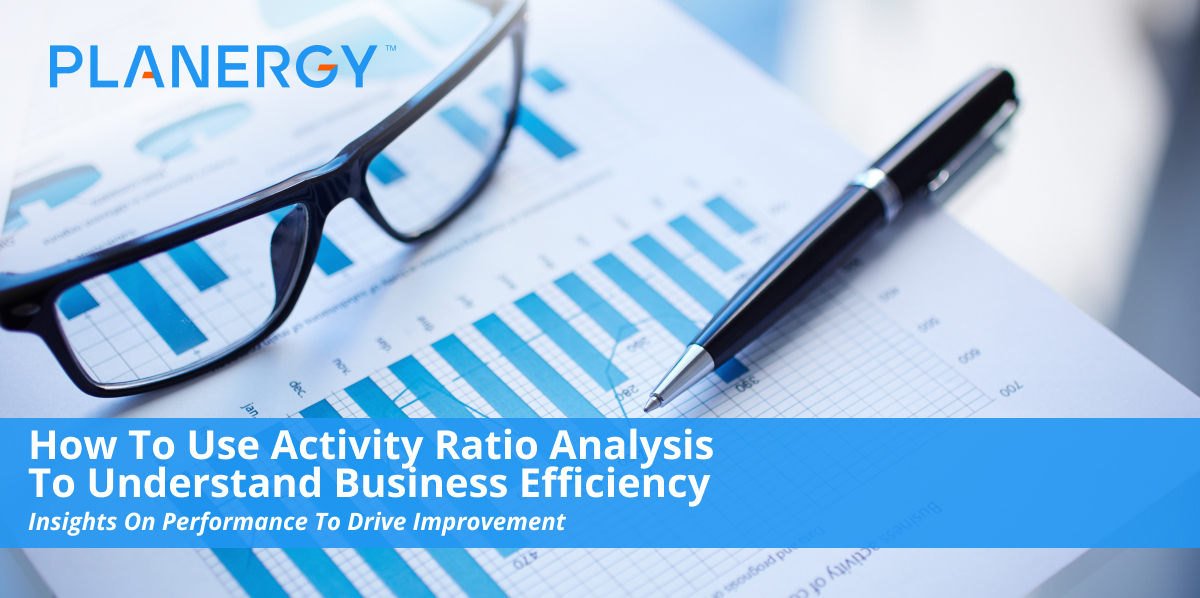Activity Ratio Analysis & Why It’s Important
Activity ratios, commonly known as efficiency ratios are designed to measure business efficiency. When used with other financial ratios such as the profitability ratio and liquidity ratio, activity ratios measure company performance, allowing business owners to see how well they’re managing their assets, and whether those assets are being used to generate income.
The numbers used to calculate activity ratios are easily found on a balance sheet. While reviewing a balance sheet can help with initial analysis, calculating the ratio can provide additional information and help track trends over an extended period easier than simple financial statement analysis.
Generally speaking, activity ratios use operating activities and expenses. Non-operating or one-time expenses such as relocation expenses or the sale of an asset are typically not included when calculating activity ratios.
Like any financial ratio, activity ratios must be properly analyzed once calculated. And like most ratios, those results should be tracked over time for better trend analysis.
7 major types of activity ratios
There is a long list of activity ratios that business owners can calculate. We’ve picked out seven of the most commonly used ratios; explaining what each ratio is used for, the formula for calculating the ratio, and what the results mean. While most activity ratios are calculated annually, you can also calculate them more frequently if you wish. The numbers used for calculating these ratios can be obtained from your balance sheet or income statement.
1. Accounts payable turnover ratio
The accounts payable turnover ratio provides a good look at how quickly your company can pay off its debts by looking at the number of days between vendor and supplier purchases and when payment is made.
The number of days used in this calculation can vary, depending on the frequency the ratio is calculated. For those calculating the accounts payable turnover ratio quarterly, the number of days used is 90, while a full year is 365 days.
The formula for calculating the accounts payable turnover ratio is as follows:
Total Purchases / Average Accounts Payable = Accounts Payable Turnover Ratio
To properly calculate this ratio, you’ll need to obtain the amount of purchases your company has made on credit for the time frame that you’re calculating the ratio for. If you’re calculating the accounts payable turnover ratio for the year, you’ll need to have the total amount of credit purchases made for the year.
Next, you’ll need to run a balance sheet for the beginning of the year and the end of the year to obtain beginning and ending accounts payable balances, you’ll need to average.
For example, let’s say that you made $925,000 in credit purchases for the year. Your beginning accounts payable balance for 2021 was $175,000 while your ending balance was $225,000, making your average accounts payable balance $200,000 for 2021. Now you can calculate your accounts payable turnover ratio.
$925,000 / $200,000 = 4.6%
A 4.6% ratio indicates that your accounts payable balance has turned over four and a half times during the year. A higher ratio is more favorable to investors and creditors, while a lower number can indicate slower payment, making your company more of a risk. The trick is to keep this number somewhere in the middle, as you don’t want to pay your bills too quickly, but you also don’t want to pay them late either.
Like any financial ratio, activity ratios must be properly analyzed once calculated. And like most ratios, those results should be tracked over time for better trend analysis.
2. Accounts receivable turnover ratio
Like the accounts payable turnover ratio, the accounts receivable turnover ratio measures how quickly your customers pay their credit accounts. To calculate this ratio, you’ll need to obtain your credit sales totals for the timeframe in question, making sure that any cash sales or unrelated revenue are subtracted from the sales total. You’ll also have to calculate your average accounts receivable balance as well.
Net Credit sales / Average Accounts Receivable = Accounts Receivable Turnover Ratio
For example, let’s say that your credit sales for the year were $1.2 million for 2021 while your beginning accounts receivable balance was $124,000 and your ending balance was $112,000, making your average accounts receivable balance $118,000.
$1,200,000 / $118,000 = 10.17
This means that your accounts receivable balance has turned over approximately 10 times during the year. A higher number indicates that your credit customers are paying you promptly, while a lower number indicates slower payment or poor credit or collection policies that may need to be reviewed.
3. Average collection period ratio
If you want to see exactly how many days it’s taking to collect your accounts receivable balances, the average collection period ratio can help. While the accounts receivable turnover ratio summarizes collection activity, it doesn’t provide the specificity that the average collection period ratio can.
Days in Period x Average Accounts Receivable / Net Sales = Average Collection Period Ratio
If you’re calculating this ratio annually, you’ll want to use 365 days in the period. You’ll also need to obtain your average accounts receivable balance as you did for the accounts receivable turnover ratio, with net credit sales obtained from your balance sheet.
Using the average accounts receivable balance and net credit sales from above, let’s calculate the average collection period ratio.
365 x $118,000 / $1,200,000 = 35.9%
This result shows that it takes your company an average of 36 days to collect payment on an invoice. The lower the ratio result, the faster you’re collecting on accounts receivable balances. How this ratio result is interpreted depends on the credit terms your customers are offered. For instance, if your credit customers are typically offered NET 30 terms, they’re paying slightly late, while if your typical credit terms are NET 45, your customers are paying you ten days early.
4. Fixed asset turnover ratio
The fixed asset turnover ratio measures the ability of your business to generate sales from your fixed assets.
Net Sales / Average Fixed Assets = Fixed Asset Turnover Ratio
To calculate this ratio, you’ll need to first find your average fixed assets total, which you can obtain from a beginning and ending balance sheet for the period in question.
Next, you’ll find your net sales total. Be sure to include both credit and cash sales in your total, and subtract any returns and allowances.
For this example, let’s say that your Net Sales for the year are $1,375,000, with a beginning fixed assets total of $82,000 and an ending balance of $90,000, making your average fixed assets balance $86,000.
$1,375,000 / $86,000 = 16%
This result indicates that for every dollar in fixed assets that your business carries, you are currently earning $16. While a higher fixed asset turnover ratio is considered desirable, too low of a result can indicate inadequate sales coupled with improper utilization of your fixed assets.
5. Inventory turnover ratio
If you own a retail business, knowing your inventory turnover ratio is essential. The inventory turnover ratio is a metric that measures how efficient your current inventory management is.
Cost of Goods Sold / Average Inventory = Inventory Turnover Ratio
To calculate the inventory turnover ratio, you’ll need two sets of numbers: your cost of goods sold for the period you’re calculating the ratio for, and your average inventory totals for that same period.
Your average inventory total can be obtained from beginning and ending balance sheets for that period, while your cost of goods sold can be found on your income statement.
For this example, let’s say that your beginning inventory for 2021 is $55,000, with an ending inventory of $54,000, while your cost of goods sold for 2021 totals $ $550,000.
$550,000 / 54,500 = 10.09%
The results above indicate that your inventory turnover for 2021 was 10%, meaning that inventory levels turned over ten times during the year. A good inventory turnover ratio is between 5-10, with a low ratio of less than 5 indicating poor product demand or weak sales, while a high ratio (over 5) indicates strong sales. Some retailers will calculate the inventory turnover ratio inclusive of all products, or calculate the ratio on one particular line of merchandise to better measure product demand.
6. Total asset turnover ratio
Similar to the fixed asset turnover ratio, the total asset turnover ratio calculation includes all company assets and is used to measure your company’s ability to use its assets to generate sales.
Net Sales / Average Total Assets = Total Asset Turnover Ratio
Designed to be calculated at year-end, the total asset turnover ratio results can vary widely from industry to industry, so when comparing your results, be sure to compare them to like companies.
Based on the information used earlier, we already know that net sales for 2021 are $1,375,000. Your beginning asset total on your balance sheet for 2021 was $100,000, with an ending balance sheet total of $98,000, making your total average assets for 2021 $99,000.
$1,375,000 / $199,000 = 6.9%
A ratio of 6.9% indicates that for each dollar of assets your company has, you’re currently able to generate $6.90 in sales. A result less than 1 indicates that assets are not being used properly, while a higher number indicates that assets are being used to generate income.
7. Working capital ratio
The final activity ratio we’ll look at is the working capital ratio. The working capital ratio looks at how efficiently your business currently uses your working capital.
Net Sales / Working Capital = Working Capital Ratio
Your working capital is a simple calculation – current assets minus current liabilities. For the year ending 2021, your current assets are $113,000, while your current liabilities are $85,000, which makes your working capital $48,000. We already know that net sales are $1,375.000.
$1,375,000 / $48,000 = 28.6%
The result means that for every $1 of liabilities, you have more than $28 in assets.
A high working capital ratio indicates that your business is using both short-term assets and liabilities to generate sales, while a lower working capital ratio can indicate bad debt or sluggish inventory movement. A good working capital ratio varies from industry to industry, so be sure to only compare your results to similar businesses but there is always room to improve your working capital and liquidity.
Limitations and disadvantages of activity ratios
While a valuable reporting tool, financial ratios such as activity ratios only provide a portion of the information you need in determining how efficient your business is currently operating. And like accounting ratios in general, activity ratios only look at historic activity, which can provide you with details on how your business has been performing to a certain point but is incapable of predicting future performance.
In addition, Activity ratios, like all accounting ratios, provide valuable information but do nothing to resolve any current financial issues. And if used out of context, the information they provide may be misleading.
Finally, if your financial statements are inaccurate, the ratios will be as well, so be sure to start with accurate financial statements.
Using activity ratios in your business
When used properly, activity ratios can tell you everything from how quickly you’re moving inventory to how fast you’re paying your suppliers.
They also provide valuable metrics for your business, showing you where your business is thriving while helping to pinpoint problem areas.
For example, if you find that your accounts receivable turnover ratio is too low, taking steps such as reassessing your credit terms and who is eligible for credit can go a long way towards improving your ratio results.
If you choose to use activity ratios in your business, you must do so consistently. Running a ratio once will tell you little about business performance, but running these ratios consistently will allow you to observe trends and address any issues as they arise. And when analyzing your ratio results, be sure to compare them with businesses in the same industry.
Running a profitable business is not easy. Having the tools necessary to facilitate growth and profitability can go a long way towards making your business sustainable in the near term and for years to come. Using tools such as activity ratios will make that task just a little bit easier.




